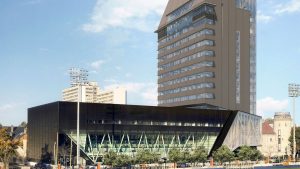An area under the Gardiner Expressway near downtown Toronto was transformed into a virtual flood recently for a weekend after sunset, as software controlled blue lighting and fog machines created simulated waves of water rising metres above the nearby street.
Called Waterlicht Toronto, the art installation aimed to call attention to the rising water levels along Toronto’s waterfront, its creator, acclaimed Dutch artist Daan Roosegaarde told the Daily Commercial News recently.
“It is a bit scary but mostly it is about triggering imagination and creativity — how we want our future to look,” he said.
Roosegaarde was the keynote speaker at Sustainable Buildings Canada’s Healthy Buildings, Healthy Planet Conference in Toronto.
“I am on a mission for clean air, clean water and clean energy.
“Some people think design is about decoration,” he said, adding in some ways the built environment is “badly designed,” causing rising Co2 emissions, flooding and air pollution. “We have to design (and engineer) our way out of it.”
While he doesn’t dismiss the value of technology as an aid in the process, Roosegaarde said human skill sets are more important such as those cited by the World Economic Forum, a not-for-profit foundation based in Geneva, Switzerland. It included creativity, cognitive flexibility, collaboration and complex problem solving on its top 10 list.
“It’s not about money, not about computers. You go to the museum or this conference not just because you think it is interesting but it trains value, which separates us from machines,” he said.
Roosegaarde and his team designed and built what he calls “the largest smog vacuum cleaner in the world,” a seven-metre-tall tower using patented positive ionisation technology to filter air pollutants, cleaning 30,000 cubic metres per hour using “a little green electricity.”
Tailored for big-city parks, it has been installed in Rotterdam and other cities around the world.
It draws on the natural connection between people, daylight and darkness
— Scott Armstrong
WSP Canada
He said the smog-reducing towers won’t solve global air pollution, “but they get people thinking” about the subject.
“That’s how you create change, step by step,” he said.
If well designed building enclosures are where energy efficiency practices start, then designers and builders will have plenty of work ahead in Toronto.
Statistics indicate 50 per cent of today’s buildings will still be standing in 2050. And many of those buildings will be in need of a retrofit.
That is the message from Scott Armstrong, project principal at WSP Canada, a consulting engineering firm.
Innovation is starting to happen now.
Toronto office building facades are increasingly being designed with 100 per cent glass, for example, he told a seminar at the conference. They are spandrel-free and clad in double or even triple glazing — the latter putting thermal performance at about R-9.
“Dynamically responsive glass” with tinting/shading characteristics is another trend, he said.
Armstrong said HOK’s circadian curtainwall system features integrated shadings/HVAC, solar and is dynamically responsive.
“It draws on the natural connection between people, daylight and darkness” without an energy performance compromise, he said.
While emphasis is placed on heating efficiency, he reminded delegates that the warming climate poses a growing challenge on how to efficiently cool buildings. Studies indicate the climate in Toronto over the past 30 years has warmed but temperatures were also “extremely erratic. It demands more of our buildings to adapt and respond.”
He said replacing a building’s glazing but not its frame is “missing an efficiency opportunity.”
Architect Drew Adams said while heritage designated sites can limit development possibilities, they can also provide architects with design latitude. That was the case at the retrofit of the historic kiln building as part of the award-winning Evergreen Brick Works development in Toronto’s Don Valley.
Without a designation in place, “We wouldn’t have necessarily rethought our approach to conditioning the space, which dropped our demand on the (temperature) conditioning side tremendously,” Adams, of LGA Architectural Partners, told delegates.
He said that had the Brick Works been developed 10 years earlier, it would have looked “entirely different” based on a “boxed approach” to issues such as flooding.
He said while the building is “not quite carbon neutral, we are almost there” because “ambitious goals” were set by Evergreen and the consulting team from day one.





Recent Comments
comments for this post are closed